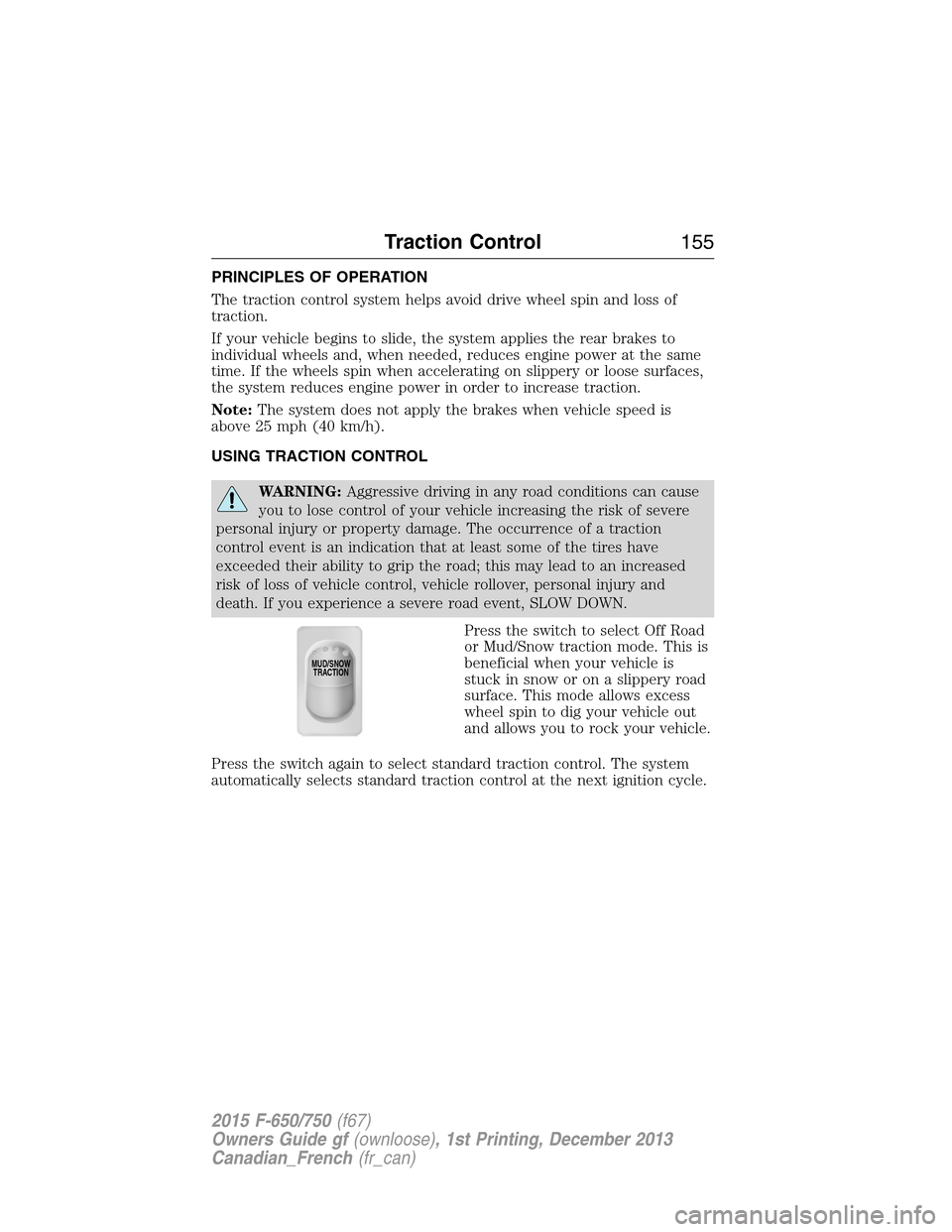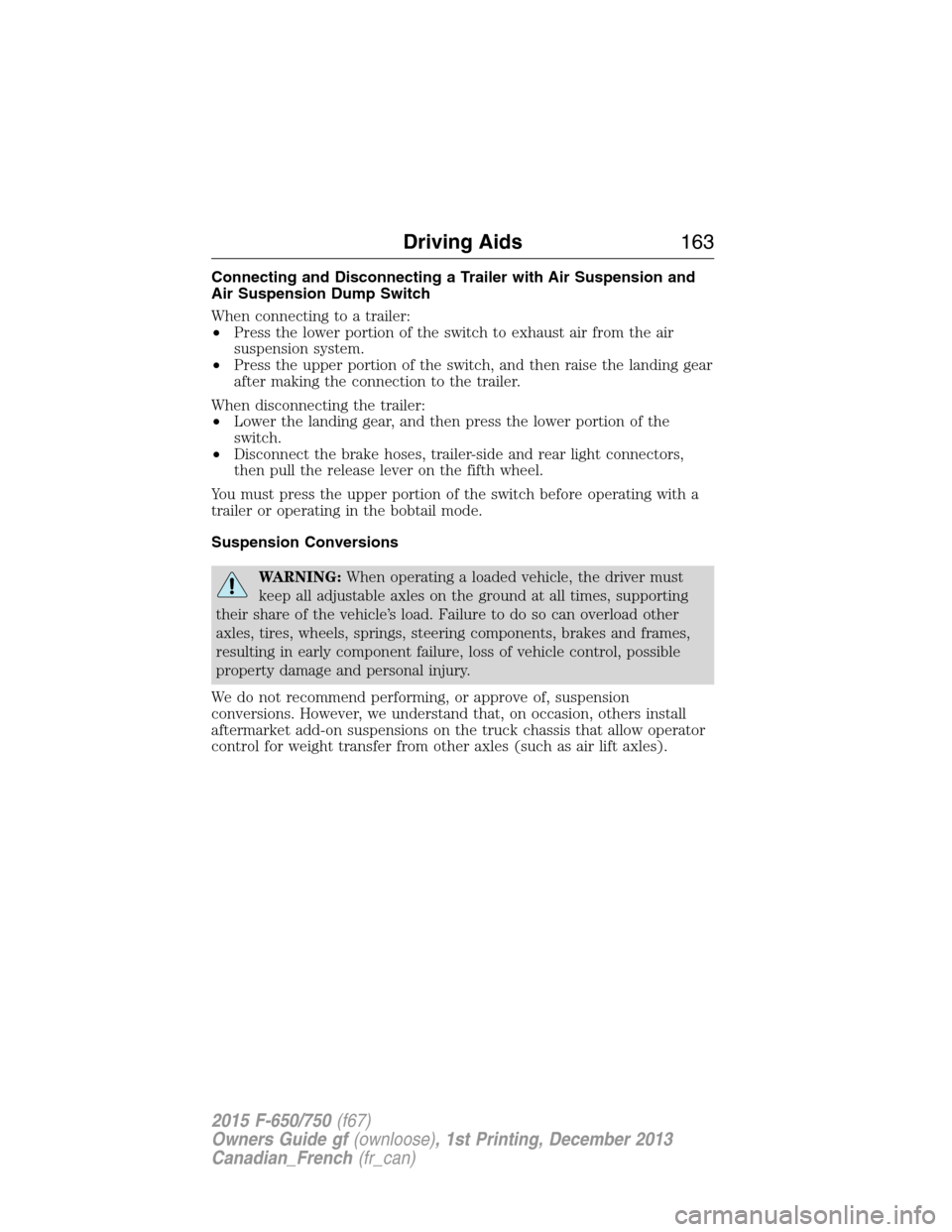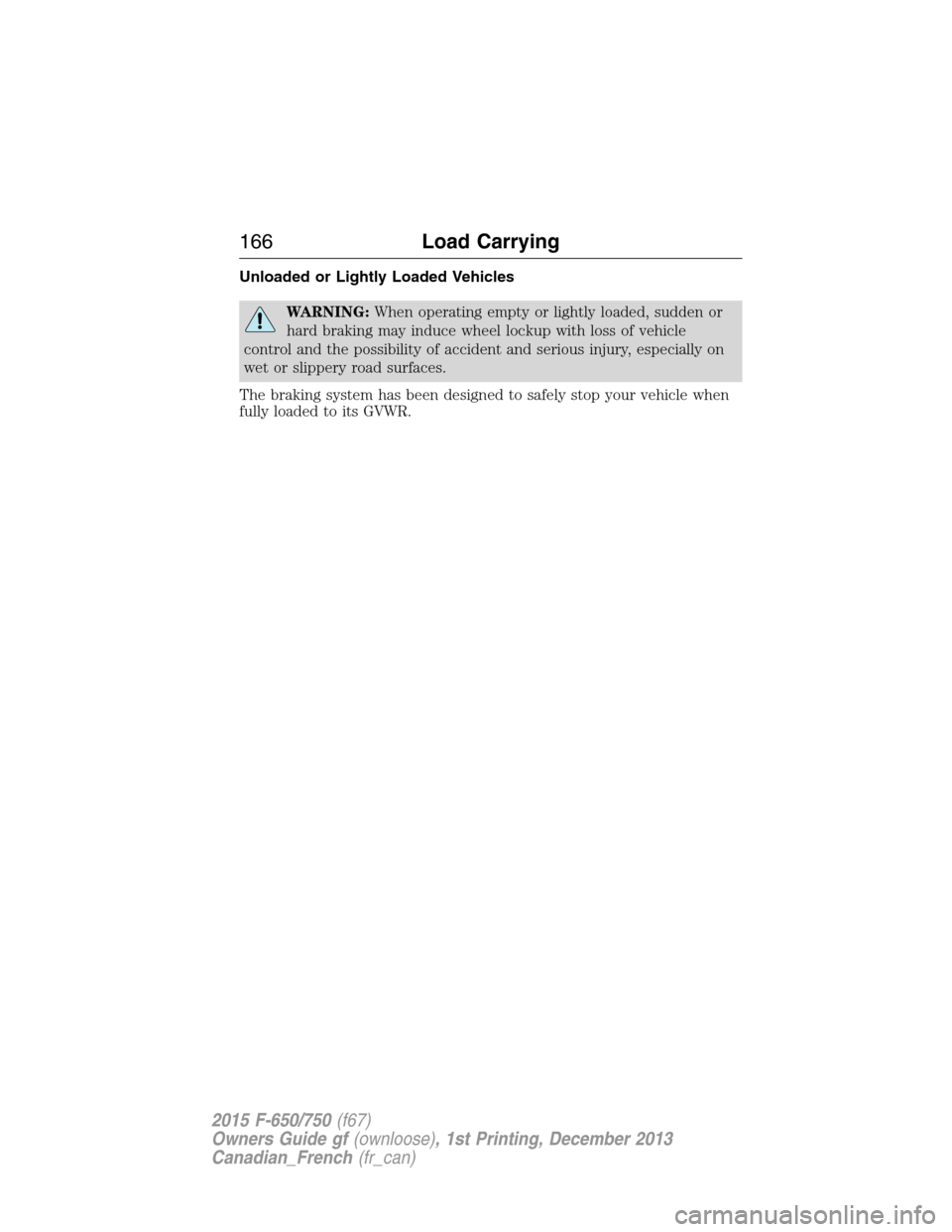2015 FORD F650 wheel
[x] Cancel search: wheelPage 154 of 384

the system with air from an outside source, releasing the spring-actuated
parking brakes. Your vehicle is now ready to tow in an emergency.
You can only use an outside air source if the protected system is in
operating condition. If you cannot restore air pressure in the protected
air system, you must release the spring-actuated brakes manually.
Releasing Spring Manually
WARNING:Do not attempt to disassemble the parking brake
chamber under any circumstances. The high spring load may
cause serious injury if the chamber clamps are removed.
If you release air pressure from the spring brake chamber, the power
spring applies the brake and, unless air pressure can be re-established,
you must release the spring brake as follows in order to move your
vehicle.
WARNING:Block the wheels to help prevent the vehicle from
moving.
WARNING:Unexpected and possibly sudden vehicle movement
may occur if these precautions are not taken.
Do not use impact wrenches as they may damage the piston and prevent
proper caging of the spring. Do not apply more than 50 foot-pounds
(68 newton-meters) torque to the release bolt nut.
1. Remove the stud tool and nut
from the carrying pocket on the
brake chamber assembly.
2. Remove the access plug from the
end of the spring chamber.
3. Insert the release stud through
the opening in the chamber and
into the spring pressure plate.
Brakes153
2015 F-650/750(f67)
Owners Guide gf(ownloose), 1st Printing, December 2013
Canadian_French(fr_can)
Page 156 of 384

PRINCIPLES OF OPERATION
The traction control system helps avoid drive wheel spin and loss of
traction.
If your vehicle begins to slide, the system applies the rear brakes to
individual wheels and, when needed, reduces engine power at the same
time. If the wheels spin when accelerating on slippery or loose surfaces,
the system reduces engine power in order to increase traction.
Note:The system does not apply the brakes when vehicle speed is
above 25 mph (40 km/h).
USING TRACTION CONTROL
WARNING:Aggressive driving in any road conditions can cause
you to lose control of your vehicle increasing the risk of severe
personal injury or property damage. The occurrence of a traction
control event is an indication that at least some of the tires have
exceeded their ability to grip the road; this may lead to an increased
risk of loss of vehicle control, vehicle rollover, personal injury and
death. If you experience a severe road event, SLOW DOWN.
Press the switch to select Off Road
or Mud/Snow traction mode. This is
beneficial when your vehicle is
stuck in snow or on a slippery road
surface. This mode allows excess
wheel spin to dig your vehicle out
and allows you to rock your vehicle.
Press the switch again to select standard traction control. The system
automatically selects standard traction control at the next ignition cycle.
MUD/SNOW
TRACTION
Traction Control155
2015 F-650/750(f67)
Owners Guide gf(ownloose), 1st Printing, December 2013
Canadian_French(fr_can)
Page 158 of 384

PRINCIPLES OF OPERATION
Cruise control lets you maintain a set speed without keeping your foot
on the accelerator pedal.
USING CRUISE CONTROL
WARNING:Do not use cruise control in heavy traffic, on
winding roads or when the road surface is slippery. This could
result in loss of vehicle control, serious injury or death.
WARNING:When you are going downhill, your vehicle speed
may increase above the set speed. The system will not apply the
brakes. Change down a gear to assist the system in maintaining the set
speed. Failure to do so could result in loss of vehicle control, serious
injury or death.
Note:Cruise control disengages if your vehicle speed decreases more
than 10 mph (16 km/h) below your set speed while driving uphill.
The cruise controls are located on
the steering wheel.
Switching On Cruise Control
Press and releaseON.
The indicator turns on in the instrument cluster.
Setting a Speed
1. Accelerate to the desired speed.
2. Press and releaseSET ACCEL.
3. Take your foot off the accelerator pedal.
R
E
S
S
E
T
A
C
C
E
L
C
OA
S
T
ON
OFF
Cruise Control157
2015 F-650/750(f67)
Owners Guide gf(ownloose), 1st Printing, December 2013
Canadian_French(fr_can)
Page 161 of 384

If you install an electrical back up alarm, connect it to the backup lamp
circuit.
Parking
WARNING:When parking your vehicle, do not leave the
transmission in gear; if the key is in the on position and the
vehicle rolls, the engine could start. Failure to follow these instructions
could result in an unattended vehicle moving, possibly causing personal
injury or property damage.
Always use the parking brake. When parking on a grade, block the
wheels and turn the front wheels to one side so that if your vehicle rolls,
the front tires act against the curb to stop your vehicle. The front wheels
are more effective at stopping a rolling vehicle than the rear wheels.
Cold Weather
Note:Idling in cold weather does not heat the engine to its normal
operating temperature. Long periods of idling in cold weather can cause
a build-up of heavy deposits of carbon and rust on valve stems causing
them to stick which, in turn, can cause valvetrain damage.
Note:We recommend against using winter fronts, or other air-restrictive
devices mounted in front of the radiator on vehicles with
chassis-mounted charge air coolers, unless extremely cold weather
conditions exist. Airflow restriction can cause high exhaust temperatures,
power loss, excessive fan usage and a reduction in fuel economy. If you
must use a winter front, the device should have a permanent opening of
at least 120 square inches (774 square centimeters) directly in line with
the fan hub.
For best engine operation in temperatures of 32°F (0°C) or lower:
•Make sure the batteries are the correct type and are fully charged.
Check other electrical components to make sure they are in optimum
condition.
•Use a permanent-type engine coolant to protect the engine against
damage from freezing.
•If your vehicle is equipped with a water-fuel separator, drain it daily.
Fill the fuel tank at the end of daily operation to prevent
condensation in the fuel system.
•Use the proper engine oil and maintain it at its proper level.
160Driving Aids
2015 F-650/750(f67)
Owners Guide gf(ownloose), 1st Printing, December 2013
Canadian_French(fr_can)
Page 162 of 384

•At temperatures of –4°F (–20°C) or below, it is recommended that
you use a crankcase-mounted coolant heater to improve cold engine
starting.
•If operating in arctic temperatures of –20°F (–29°C) or lower, consult
your truck dealer for information about special cold weather
equipment and precautions.
Hot Weather
•Use a permanent-type engine coolant to protect the engine against
damage from overheating.
•Fill the fuel tank at the end of daily operation to prevent
condensation in the fuel system.
•Keep external surfaces of the engine, radiator, charge air cooler, air
conditioning condenser and accessories clean to avoid dirt build-up.
•You may experience above normal coolant temperatures while driving
in a transmission gear ratio that lugs the engine. To correct this
problem, increase engine speed by downshifting into the next lower
gear.
STEERING
Your vehicle is equipped with power steering. Power steering uses energy
from the engine to decrease the driver’s effort in steering your vehicle.
To help prevent damage to the power steering pump:
•Never hold the steering wheel to the extreme right or the extreme
left for more than a few seconds when the engine is running.
•Do not operate your vehicle with the power steering pump fluid level
below the ADD mark on the MAX COLD side of the power steering
reservoir dipstick.
•Some noise is normal during operation. If the noise is excessive,
check for low power steering pump fluid level before seeking service
by an authorized dealer.
•Low power steering pump fluid levels may cause heavy or uneven
steering efforts. Check the power steering pump fluid level before
seeking service from an authorized dealer.
•Do not fill the power steering pump reservoir above the FULL mark
on the MAX HOT side of the power steering reservoir dipstick, as this
may result in leaks from the reservoir.
If the power steering system breaks down (or if the engine is turned
off), you can steer your vehicle manually, but it takes more effort.
Driving Aids161
2015 F-650/750(f67)
Owners Guide gf(ownloose), 1st Printing, December 2013
Canadian_French(fr_can)
Page 163 of 384

If the steering wanders or pulls, check for:
•Underinflated tire(s) on any wheel(s)
•Uneven vehicle loading
•High crown in center of road
•High crosswinds
•Wheels out of alignment
•Loose or worn suspension components.
AIR SUSPENSION (IF EQUIPPED)
Note:Do not operate your vehicle without air in the suspension springs.
Operating your vehicle without air in the suspension springs damages the
suspension, degrades ride performance and may cause property damage.
The air suspension system automatically adjusts to different loads to
maintain a constant frame height, allows for ease of vehicle loading,
provides improved vehicle ride, and increased driver comfort.
Air Suspension Dump Switch
Note:The suspension dumps air when the ignition is in the accessory or
on position, but fills only when the ignition is in the on position.
A switch located in the overhead
switch pack controls the system. It
operates only when the ignition is in
the accessory or on position and the
air tanks have sufficient pressure to
fill the air springs. When you turn
off the ignition, the suspension
remains in whatever state it was last
set.
Pressing the lower portion of the switch exhausts air from the air
springs, lowering the frame for loading. Pressing the upper portion of the
switch fills the air springs so your vehicle remains at normal ride height.
System Indicator Light
The air suspension indicator light illuminates when using the
switch to release air pressure in the rear air shocks. Never
drive your vehicle when the warning lamp is illuminated and
there is low (or no) air pressure in the shocks.
CK
SUSP
162Driving Aids
2015 F-650/750(f67)
Owners Guide gf(ownloose), 1st Printing, December 2013
Canadian_French(fr_can)
Page 164 of 384

Connecting and Disconnecting a Trailer with Air Suspension and
Air Suspension Dump Switch
When connecting to a trailer:
•Press the lower portion of the switch to exhaust air from the air
suspension system.
•Press the upper portion of the switch, and then raise the landing gear
after making the connection to the trailer.
When disconnecting the trailer:
•Lower the landing gear, and then press the lower portion of the
switch.
•Disconnect the brake hoses, trailer-side and rear light connectors,
then pull the release lever on the fifth wheel.
You must press the upper portion of the switch before operating with a
trailer or operating in the bobtail mode.
Suspension Conversions
WARNING:When operating a loaded vehicle, the driver must
keep all adjustable axles on the ground at all times, supporting
their share of the vehicle’s load. Failure to do so can overload other
axles, tires, wheels, springs, steering components, brakes and frames,
resulting in early component failure, loss of vehicle control, possible
property damage and personal injury.
We do not recommend performing, or approve of, suspension
conversions. However, we understand that, on occasion, others install
aftermarket add-on suspensions on the truck chassis that allow operator
control for weight transfer from other axles (such as air lift axles).
Driving Aids163
2015 F-650/750(f67)
Owners Guide gf(ownloose), 1st Printing, December 2013
Canadian_French(fr_can)
Page 167 of 384

Unloaded or Lightly Loaded Vehicles
WARNING:When operating empty or lightly loaded, sudden or
hard braking may induce wheel lockup with loss of vehicle
control and the possibility of accident and serious injury, especially on
wet or slippery road surfaces.
The braking system has been designed to safely stop your vehicle when
fully loaded to its GVWR.
166Load Carrying
2015 F-650/750(f67)
Owners Guide gf(ownloose), 1st Printing, December 2013
Canadian_French(fr_can)